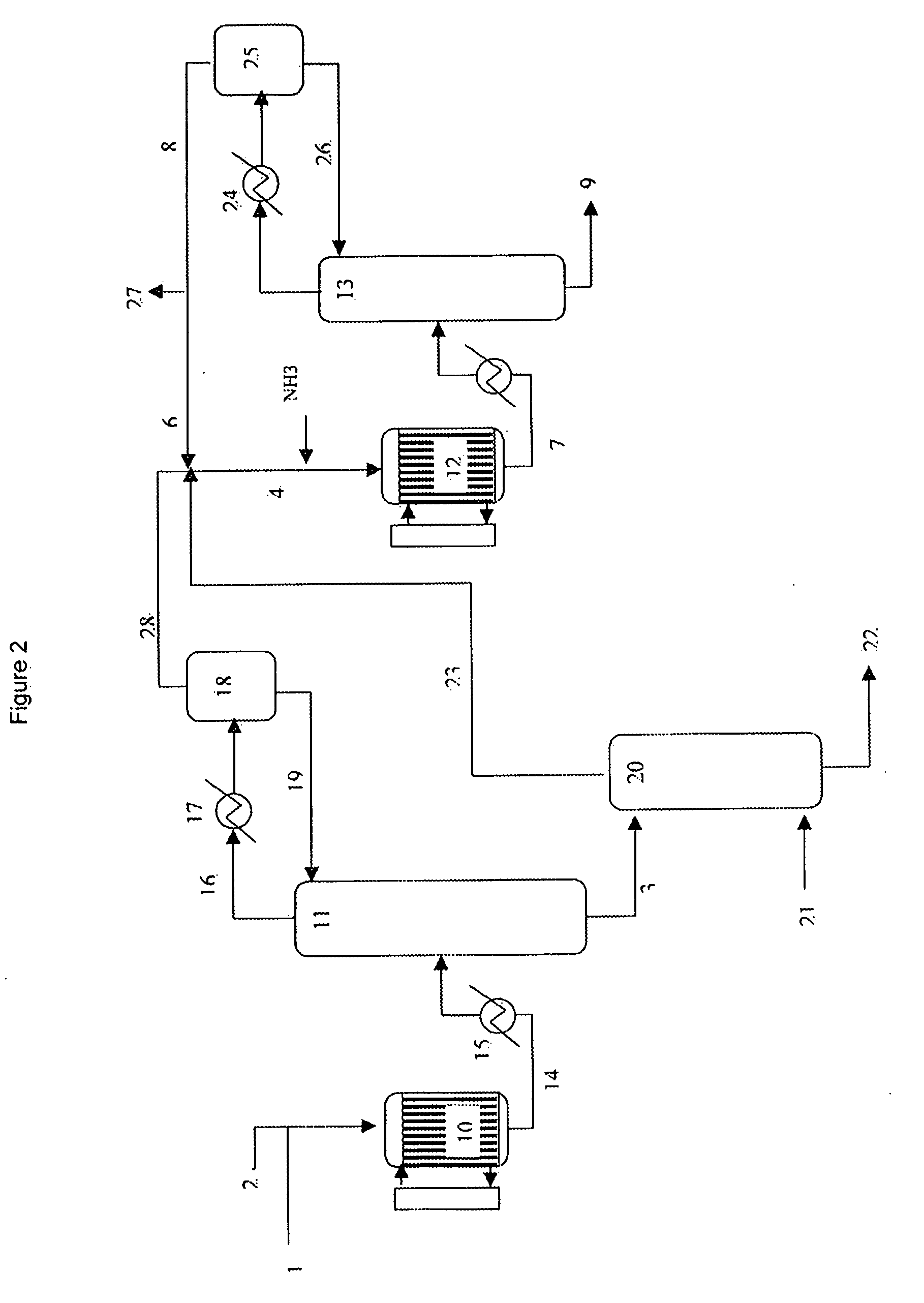Method for the synthesis of acrylonitrile from glycerol
a technology of acrylonitrile and glycerol, which is applied in the preparation of carboxylic acid nitrile, organic chemistry, and hydrogen cyanide addition, etc., can solve the problems of acetonitrile, considering its limited applications, being generally destroyed, and costing the reactor a premium, and being also proportional to the cost of installation
- Summary
- Abstract
- Description
- Claims
- Application Information
AI Technical Summary
Benefits of technology
Problems solved by technology
Method used
Image
Examples
example 1
With Reference to FIG. 2
[0085]A simulation using ASPEN software was used to illustrate the process according to the invention. The values are given in kmol / hour. For the sake of clarity, only the main constituents are indicated.
[0086]A gas stream at 331° C. and at 2.0 bar (188 kmol / h glycerol, 963 kmol / h water, 426 kmol / h nitrogen, 113 kmol / h oxygen) is sent into a fixed-bed multitubular reactor (10) containing a heterogeneous dehydration catalyst coupled to a molten salt bath. A gas stream (14) at 320° C. and at 1.7 bar (1336 kmol / h water, 426 kmol / h nitrogen, 78 kmol / h oxygen, 147 kmol / h acrolein, 19 kmol / h acetaldehyde, 25 kmol / h CO, 13 kmol / h CO2) exits this reactor. This stream is cooled to 151° C. in a heat exchanger (15) and sent to the bottom of an absorption column (11) that comprises 4 theoretical plates. The gas stream (16) that exits at 102° C. at the top of this absorption column is sent to a partial condenser (17) which cools it to 79° C., then to a flash chamber (18) ...
example 2
Acrolein Preparation
[0096]A tubular reactor composed of a tube having a length of 35 cm and an internal diameter of 22 mm is used to carry out the dehydration reaction of glycerol in the gas phase at atmospheric pressure. This reactor is placed in a heated chamber maintained at the reaction temperature, which is 300° C., unless otherwise indicated. The catalyst used is milled and / or pelleted in order to obtain particles of 0.5 to 1.0 mm. 10 ml of catalyst are charged in the reactor to form a catalytic bed having a length of 5 cm. This bed is brought to the reaction temperature for 5 to 10 minutes before the introduction of the reactants. The reactor is fed with a 20 wt % aqueous solution of glycerol with an average feed rate of 12 ml / h, and with a flow rate of 0.8 1 / h of molecular oxygen for the examples according to the invention. In this case, the relative O2 / vaporized glycerol / water vapor proportion is 6 / 4.5 / 89.5. The aqueous glycerol solution is vaporized in the heated chamber, ...
example 3
Synthesis of Acrylonitrile
[0101]A pyrex reactor is charged with a catalyst bed. The reactor is equipped with a frit in order to retain the catalyst. The reactor is first charged with a mass of 6.578 g of catalyst for the oxidation of propylene to acrolein which is produced by Nippon Shokubai with reference ACF4, used in this example as an ammoxidation catalyst although it is not optimized for this reaction, diluted with 7 ml of silicon carbide having a particle size of 0.125 mm. Charged next are beds of silicon carbide having a particle size of 0.125 mm in an amount of 2 ml, and then 7 ml of 0.5 mm. And finally the reactor is completed with 1.19 mm silicon carbide up to the top of the reactor.
[0102]The reactor is then connected to the test installation. The temperature of the catalyst is regulated at 420° C. and the HSV is adjusted to 1200 h−1.
[0103]The reactor is fed with a gas mixture of 4.5% acrolein / 8.7% oxygen / 5.4% ammonia / (remainder) helium-krypton / 15% water. The helium-krypto...
PUM
| Property | Measurement | Unit |
|---|---|---|
| concentration | aaaaa | aaaaa |
Abstract
Description
Claims
Application Information
 Login to View More
Login to View More - R&D
- Intellectual Property
- Life Sciences
- Materials
- Tech Scout
- Unparalleled Data Quality
- Higher Quality Content
- 60% Fewer Hallucinations
Browse by: Latest US Patents, China's latest patents, Technical Efficacy Thesaurus, Application Domain, Technology Topic, Popular Technical Reports.
© 2025 PatSnap. All rights reserved.Legal|Privacy policy|Modern Slavery Act Transparency Statement|Sitemap|About US| Contact US: help@patsnap.com


